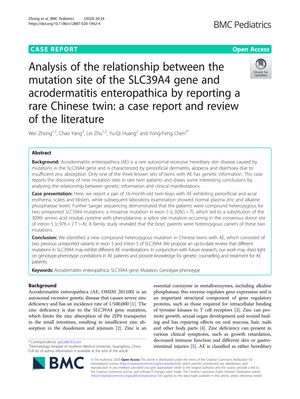Analysis of the Relationship Between the Mutation Site of the SLC39A4 Gene and Acrodermatitis Enteropathica: A Case Report and Literature Review
January 2020
in “
BMC pediatrics
”

TLDR New mutations in the SLC39A4 gene found in twins help understand the genetic cause of acrodermatitis enteropathica.
In a study from January 27, 2020, researchers reported on a pair of 16-month-old Chinese twin boys with acrodermatitis enteropathica (AE), a rare autosomal recessive skin disease caused by mutations in the SLC39A4 gene. Despite normal plasma zinc and alkaline phosphatase levels, the twins exhibited symptoms such as periorificial and acral erythema, scales, and blisters. Genetic analysis through Sanger sequencing revealed that the twins were compound heterozygous for two previously unreported mutations in the SLC39A4 gene: a missense mutation in exon 5 and a splice site mutation in intron 5. The parents were found to be heterozygous carriers of these mutations. This discovery of new mutation sites in the twins contributes to the understanding of the genetic basis of AE and suggests that different mutations in the SLC39A4 gene may lead to different clinical manifestations of the disease. The findings may assist in future genotype-phenotype correlation studies, genetic counseling, and treatment strategies for AE.

